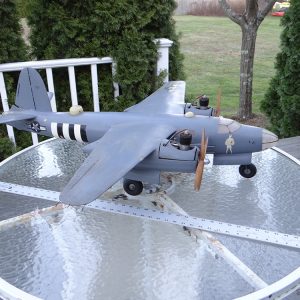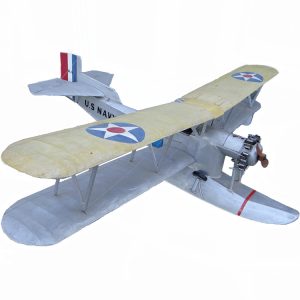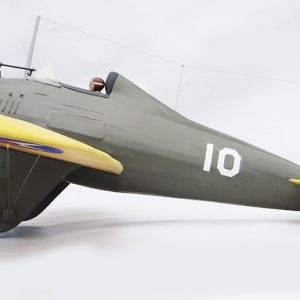The Martin B-26 ‘Marauder’ was one of the best known twin engine US Army Air Force medium bombers of World War-II. The B-26 was, after correction of early design problems, first saw action in the Pacific during the Battle of Midway in the summer of 1942. Most B-26s operated in Europe and were very successful tactical bombers. They were the fastest bomber in the Army Air Force and had the best record of any bomber for getting their crews back to their bases.
Click here for for a history of the B-26:
This fine large flying model of the ‘Marauder’ was built in California in 1945 and is powered by two early spark ignition ‘McCoy 35’ gasoline model airplane engines using specially built four blade propellers (like the actual B-26). Model airplane engines of this early flying model period used miniature spark plugs for engine ignition and had to have battery powered condensers and coils inside the plane’s fuselage to manage proper timing & cylinder ignition. In the late 1940s the familiar and much simpler ‘glo plug’ model plane engine was developed. In the years when this model was built flying model airplanes were controlled in the air via ‘U-control’. With this control system up/down wires were attached to the model plane’s elevators on the rear of the plane’s horizontal stabilizer. These wires passed through the fuselage and wing to eyelets at the wingtip which were attached to wire cables ending in a ‘D’ shaped handle. The modeler, given he could get the engine/s started, would stand in a field with the control handle and as many yards of wire as he felt comfortable with attached to the control handle. His wrist action working the elevator wires would make the plane take off. The plane thus linked to the modler by these control wires would fly in a circle with modler pilot at the center – climb and dive through his hand control – until the ‘pilot’ decided to attempt landing or the plane ran out of gas.
This is an unusually large and powerful flying model and required a third wire attached to the wing tip and to an iron stake driven into the flying field so the plane could not get away from its pilot. Flying a ‘U-control’ model of this size and power must have been quite an experience and this model must have been a ‘real handful’ as was the full size B-26. Very few flying models of this size were built in the period of ‘U-control’.
This B-26 bears the black and white Invasion Stripes which were painted on US aircraft for the ‘D-Day’ allied invasion of Normandy, France in June of 1944. These invasion stripes were meant to help quickly identify allied aircraft during the Battle of France. This model B-26 is painted ‘Photo-Recon-Blue’ indicating the prototype of the model was a B-26 used for reconnaissance missions over the battlefield and behind enemy lines. The B-26 was a good choice for this kind of mission since it could be equipped to fly faster than most of the German fighters who would try to shoot it down.
We obtained this rare and finely built model from the son of its original builder who told us the model was built by his father in 1945. We have had it in our own collection for years. The model is in fine original condition retaining 95% original paint, original tires, engines, markings, etc. This is a rare flying model of an historic plane built in the period of its prototype’s use.
Dimensions: 48″ wingspan, 44′ fuselage length
Price: $1700.00
A fine vintage 1950 model of the early US Navy OL-8 amphibean biplane.
Loening was a pioneer in the development of seaplanes and amphibean aircraft and his designs were flying at the time of WW-I. In 1923 the first Loening Amphibean appeared and examples were purchased by the US Navy for scouting and observation operations. In the course of the ’20s this radial engine version, the OL-8, appeared and twenty of them were built. These aircraft were used for the Alaskan Arial survey of 1923. The OL-8 was also used to fly relief missions after the 1928 earthquake in Haiti. In the early 1930s Loening became a part of the new Grumman Aircraft Company which became one of the most famous designers and builders of aircraft in the USA.
The Loening was a fascinating early amphibean and a fine example of 1920s aircraft design. Please see the links below for photos and descriptions of the actual aircraft:
- Click Here for information on the Loening aircraft
- Click Here for photo of Loening Aircraft
- Click Here for many photos of Loening Aircraft
- Click Here for another photo of this aircraft
Though a very neat and interesting looking aircraft very few fine models of the Loening Amphibean were built. This vintage model, built circa 1950, is built on a wooden frame covered with typical model aircraft paper – the prime material for building flying models of the period – and is fitted with a ‘glow plug’ ignition gas engine of the period.
This model was also intended to carry one of the earliest radio control units available. These R/C units were simple one function designs and on this model could control only the right/left movement of the rudder. This OL-8 was built as a ‘free flight’ model in that its ‘pilot’ launched it by hand (when he could get the engine started) and by use of the R/C control the plane would fly in a circle in a large field and, when out of gas, land on a flat smooth grass surface. Though the bottom hull surfaces of this madel were somewhat reinforced, and biplanes can glide well, a successful free flight landing for this model would have been a gamble, and a water landing + recovery in one piece probably not possible.
We suspect the builder of this fine and highly detailed scale model never flew it since the model is in excellent original condition with original paint, USN markings, and pilot plus observer in the cockpit. The engine detail is excellent with the cylinder of the working engine fitted among the modeled radial engine cylinders, the wing and tail reinforcing wires were also rigged. The radio control unit is not present and we guess the highly skilled modeler who built this OL-8 decided the fun of flying it was not worth the risk of its destruction and never put the R/C unit in the fuselage. The majority of 1950s flying models were delicate and one bad landing would finish them. Consequently very few vintage flying airplane models have survived – especially one of this rare type and quality.
Dimensions: 38″ long x 45″ wingspan
Price: $1250.00
In 1931 Boeing Aircraft Company found that it’s new twin engine bomber, B-9, was faster than all US fighter planes. Therefore, Boeing set out to design a fighter plane fast enough to deal with the new bomber. Boeing’s P-26 was the result and went into production in January 1932. The P-26 was the first US single wing fighter and some of its design features were based on American racing planes of the period. The P-26 was a handful in the air and a bit tricky to land.
The P-26 was a great looking plane with lots of character. The P-26 can truly be called, ‘cute’, especially with the bright colors and US ARMY AIRFORCE markings of the period. A few P-26 fighters actually saw service against the Japanese in the early days of World War II.
This excellent quality non-flying scale model of this famous fighter was built in the 1940 – 1950 period in the traditional manner of model plane building at the time – the wings, fuselage, and tail structure were built with carved wooden ribs/frames and forms called stringers, then the this skeleton was covered with a paper skin, and the skin was given several coats of airplane-dope lacquer which made it relatively strong and tight. Engine detail, wire bracing, landing gear, etc. was incorporated before doping. Good plans for model airplanes were published in Model airplane magazines and other publications like ‘Popular Mechanics’. It required considerable skill and time to complete a model as well made, detailed, and well finished as this one.
Due to their materials and method of construction – similar to the actual wood, aluminum, and fabric construction of the real plane – very few vintage models and even fewer actual planes have survived. Below are links to view the only airworthy P-26 in operation, and a second link on P-26 history.
Click Here to see the P-26 in action
Click Here for P- 26 history
Condition: This model P-26 is in excellent original condition. The surface is exceptional with original paint and markings (one very minor skin repair on upper left wingtip) and lovely patina. Guy wires are intact as is engine detail and landing gear.
This is a truly charming and attractive period model for the collector, or anyone who appreciates early aircraft.
Dimensions: wingspan 28″, fuselage 24″,max. height 11″
Price: $375.00



